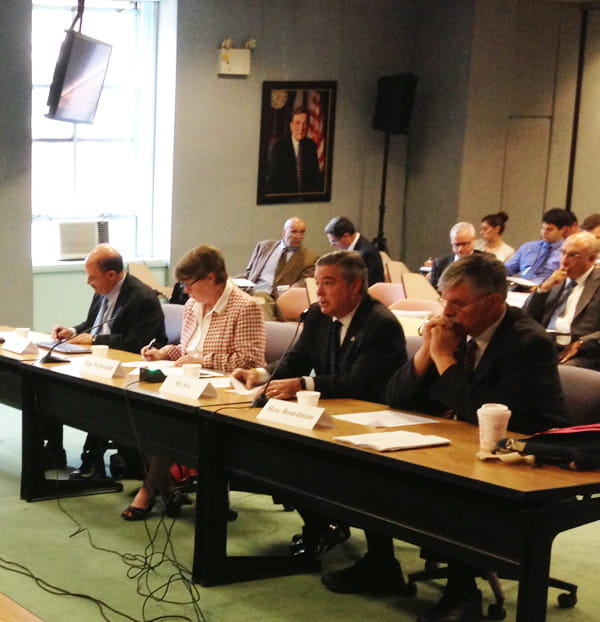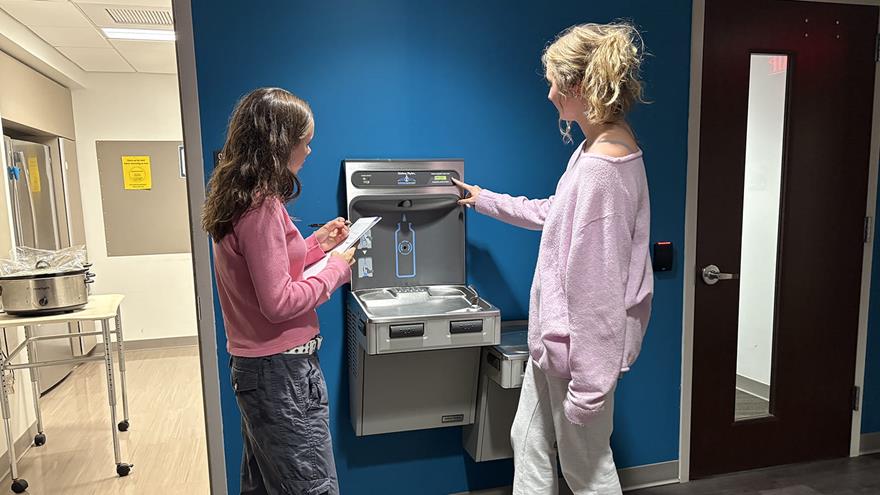Drexel President John Fry Testifies Before House Committee on Amtrak’s NE Corridor

Drexel President John Fry traveled to New York City on Friday to testify before the chairman and members of the Committee of Transportation of the U.S. House of Representatives on the future of Amtrak’s Northeast Corridor and the benefits of private involvement in train service along the corridor. The Northeast Corridor stretches along 450 miles from Washington to Boston and is home to four of the most populous metro regions in the nation: New York, Boston, Philadelphia and Washington D.C.
“It’s fair to say that this is the epicenter of American rail travel,” Fry said. “It’s also the epicenter of sustained urban living in the nation, and there’s no coincidence there.”
Fry’s testimony touched on the need for officials at Amtrak and in the communities that it serves to consider ways to better integrate train stations with surrounding communities as a strategy for fueling smart urban development.
Fry noted the demographic and social trends that are contributing to the rebirth of urban environments and leading urban growth: the millennial generation with a strong preference to work, live and socialize in urban versus suburban or rural environments; aging baby boomers whose children are grown who are downsizing to cities for convenience, for culture and for the overall social environment of city life; and highway systems and major airports near urban centers that are stretching beyond their capacity, and are essentially unable to expand service.
“Across the country I have seen the need to fix our Nation’s ports, bridges, tunnels, and rails so we can have a more efficient and reliable transportation network in the future,” said Committee on Transportation and Infrastructure Chairman Bill Shuster, who also participated in today’s hearing in New York’s Moynihan Station. “However we recognize that we do not have unlimited funds, so we need to focus on what makes sense and prioritize investment in infrastructure that we know is achievable. High speed rail, while great in theory, is not realistic given the corridor’s immediate need for state-of-good repair improvements.”
Unlike highways and airports that have expanded beyond their capacity, the largely untapped Northeast Corridor rail service can be leveraged to take advantage of current societal and infrastructure trends, Fry told Shuster and members of the Subcommittee on Railroads, Pipelines and Hazardous Materials. Other witnesses included Amtrak CEO Joseph Boardman, Bob Yaro, executive director of the Regional Plan Association, and Joan McDonald, commissioner of the New York State Department of Transportation.
Fry cited Drexel’s partnership with Amtrak to explore the feasibility of jointly developing air rights over rail yards and adjacent parcels as an example of how both public and private organizations can work together to unlock the limited financial resources available to Amtrak, the other rail operators and federal and state governments.
The air rights will be one of the key dimensions of the planning process Amtrak will undertake with Drexel, the city, the Pennsylvania Department of Transportation and a host of other stakeholders.
“This, of course, is a project measured in decades rather than years,” said Fry. “But the time is right to start the work, and begin similar conversations that can happen, and in fact are happening, all along the Northeast Corridor”
He also described the benefits of Drexel’s “Innovation Neighborhood”—an ambitious undertaking and the cornerstone of Drexel’s comprehensive campus master plan for a mixed-use, live/learn/work development on more than 12 acres of poorly used land between Drexel and Philadelphia’s 30th Street Station.
“Imagine the impact for Philadelphia when visitors arrive at the city’s most convenient transportation hub and disembark right into a brand-new neighborhood dedicated to learning, to innovation and to entrepreneurship,” Fry said.
The Innovation Neighborhood is how Drexel University and the city of Philadelphia have responded to the opportunity for urban renewal presented by rail transportation. There are similar, yet unique, opportunities in every hub on the corridor, according to Fry. “Whether it’s in Philadelphia, Washington, Boston or Baltimore or even Lancaster, these ideas represent a bold new vision for our urban cores.” And the wider the range of partners involved, the better, Fry argued—from rail operators to real estate developers, to business and retail owners, to regional economic development groups and local, state and federal governments, to anchor community institutions including universities, hospitals, museums and more.
“I know we’re entering a new era where urban train stations are once again a centerpiece not only of travel but of commerce and learning,” Fry said in his closing remarks. “These stations have great existing value, which we must unleash to create funds to invest in a reliable, comfortable and affordable rail system serving the 17 percent of Americans who live on the Northeast Corridor.
To read the full testimonies, visit: Field Hearing: The Importance of the Northeast Corridor
The Washington Post covered the hearing on the future of the Northeast Corridor. The article is available at: Committee examines Amtrak’s NE Corridor
In This Article
Contact
Drexel News is produced by
University Marketing and Communications.
